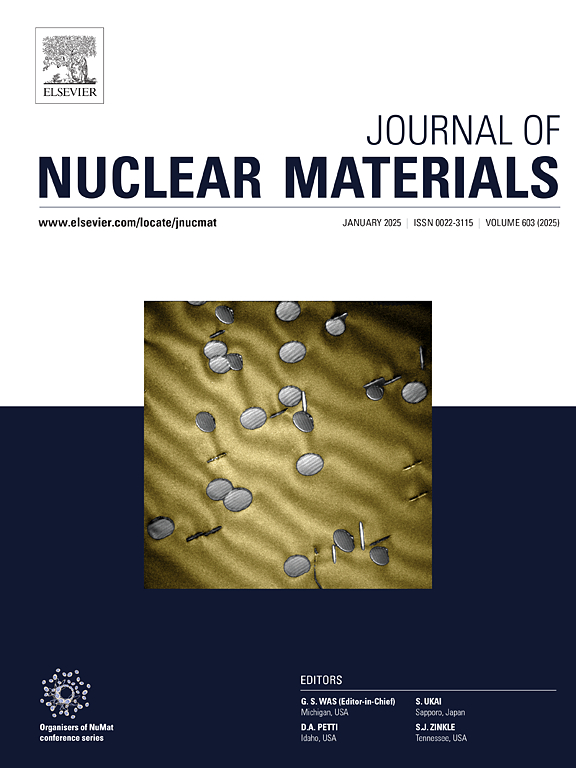Synthesis of B2O3-Bi2O3-ZnO glass-(Ag)iodosodalite by iodine loaded silver-coated silica gel
IF 3.2
2区 工程技术
Q3 MATERIALS SCIENCE, MULTIDISCIPLINARY
引用次数: 0
Abstract
Efficient immobilization of 129I is of great significance for the development of the nuclear industry due to its long half-life and high mobility in the environment. Aiming at radioactive iodine-adsorbed waste treatment, iodine-loaded silver-coated silica gel was immobilized into B₂O₃-Bi₂O₃-ZnO glass-(Ag)iodosodalite with varying Al/Si ratios and glass content. XRD results showed that increasing the Al/Si ratio can reduce the formation temperature and inhibit the decomposition of iodosodalite at high temperatures, while the addition of borate glass content reduces the formation temperature of (Ag) iodosodalite from 800 °C to 500 °C. The synthesized B₂O₃-Bi₂O₃-ZnO glass-(Ag) iodosodalite consists of irregular grains with an I content of 11.8 wt. %, indicating that 92.2 % of I ions are immobilized and only 7.8 % escape. Chemical stability analysis indicates that the iodine leaching rate is on the order of 10⁻⁶ g/(m²·d).
负载碘的镀银硅胶合成B2O3-Bi2O3-ZnO玻璃-(Ag)碘烟石
由于129I的半衰期长,在环境中的流动性高,因此高效固定化对核工业的发展具有重要意义。摘要针对放射性碘吸附废物的处理,采用不同Al/Si比和玻璃含量的B₂O₃- bi₂O₃- zno玻璃-(Ag)碘石固定载碘银包覆硅胶。XRD结果表明,提高Al/Si比可以降低碘烟石在高温下的形成温度,抑制碘烟石的分解,而硼酸盐玻璃含量的加入使(Ag)碘烟石的形成温度从800℃降低到500℃。合成的B₂O₃- bi₂O₃- zno玻璃-(Ag)碘索岩由不规则颗粒组成,I含量为11.8% wt. %,表明92.2%的I离子被固定,只有7.8%的I离子逃逸。化学稳定性分析表明,碘的浸出率约为10⁻26 g/(m²·d)。
本文章由计算机程序翻译,如有差异,请以英文原文为准。
求助全文
约1分钟内获得全文
求助全文
来源期刊

Journal of Nuclear Materials
工程技术-材料科学:综合
CiteScore
5.70
自引率
25.80%
发文量
601
审稿时长
63 days
期刊介绍:
The Journal of Nuclear Materials publishes high quality papers in materials research for nuclear applications, primarily fission reactors, fusion reactors, and similar environments including radiation areas of charged particle accelerators. Both original research and critical review papers covering experimental, theoretical, and computational aspects of either fundamental or applied nature are welcome.
The breadth of the field is such that a wide range of processes and properties in the field of materials science and engineering is of interest to the readership, spanning atom-scale processes, microstructures, thermodynamics, mechanical properties, physical properties, and corrosion, for example.
Topics covered by JNM
Fission reactor materials, including fuels, cladding, core structures, pressure vessels, coolant interactions with materials, moderator and control components, fission product behavior.
Materials aspects of the entire fuel cycle.
Materials aspects of the actinides and their compounds.
Performance of nuclear waste materials; materials aspects of the immobilization of wastes.
Fusion reactor materials, including first walls, blankets, insulators and magnets.
Neutron and charged particle radiation effects in materials, including defects, transmutations, microstructures, phase changes and macroscopic properties.
Interaction of plasmas, ion beams, electron beams and electromagnetic radiation with materials relevant to nuclear systems.
 求助内容:
求助内容: 应助结果提醒方式:
应助结果提醒方式:


